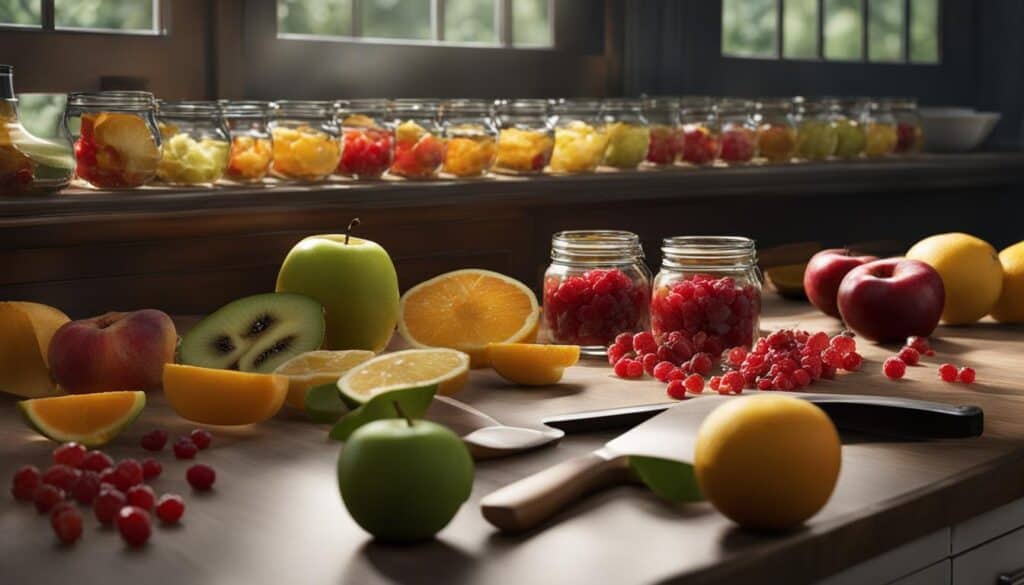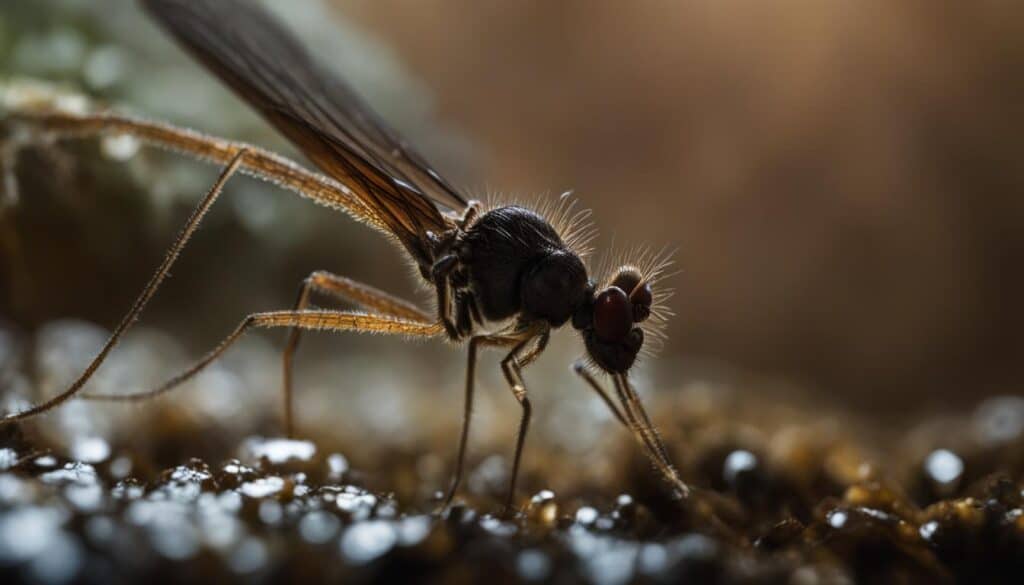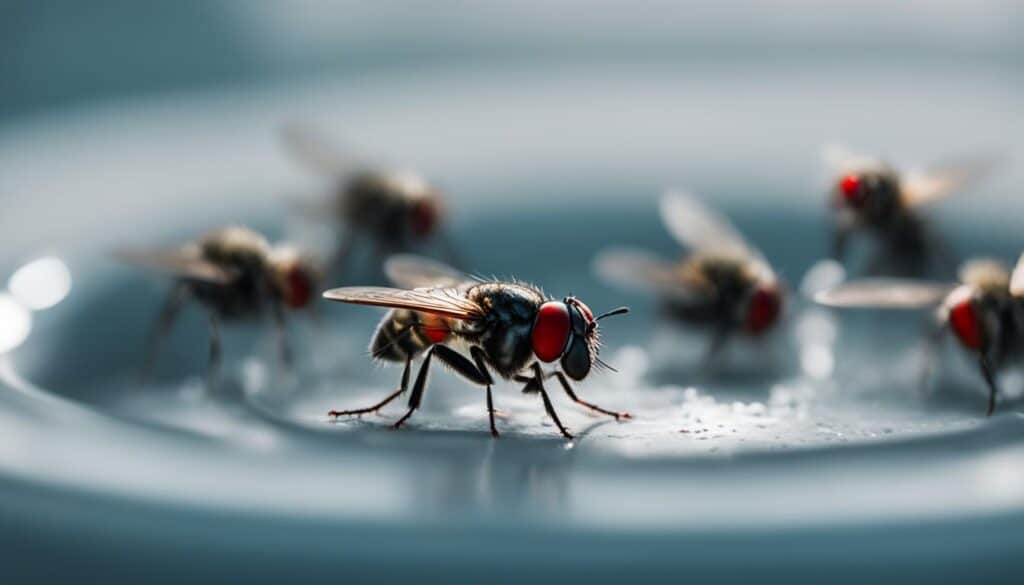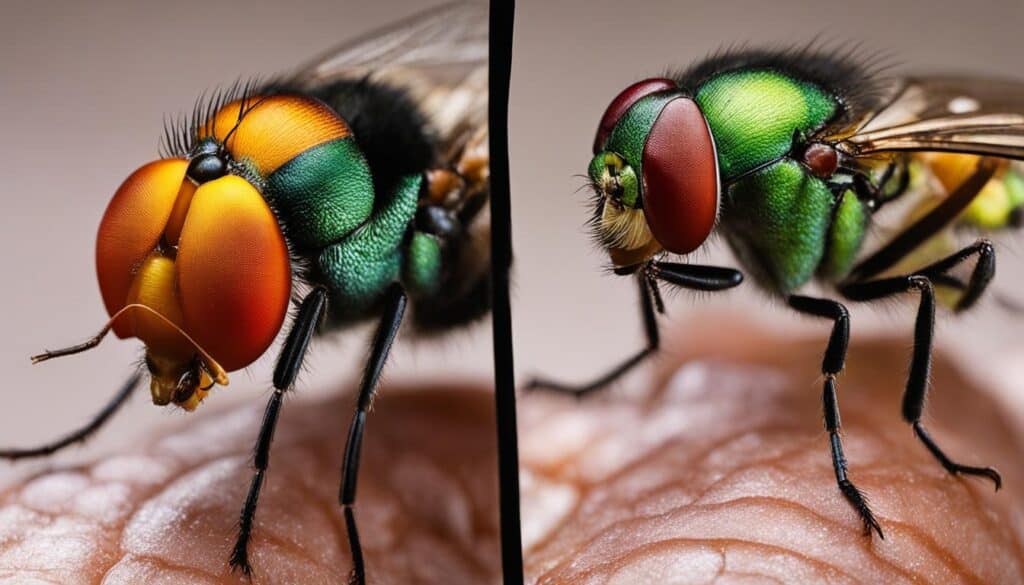Are you tired of dealing with pesky fruit flies buzzing around your kitchen? I know I am! Fruit fly infestations can be quite frustrating, but fear not, because I’m here to help you understand why these little insects invade your house and provide you with some effective solutions and tips to get rid of them.
Fruit flies, also known as Drosophila melanogaster, are attracted to ripened fruit and vegetables, as well as fermenting products. These tiny insects, measuring only 3 to 4 mm in length, can have red eyes or dark eyes. Their lifecycle consists of four stages: eggs, larva, pupa, and adult, and it can last around 25 days. Fruit flies reproduce rapidly, especially during the summer, and they can be found in moist areas with organic material and standing water, both indoors and outdoors.
To prevent fruit fly infestations, it’s important to maintain cleanliness in your kitchen. Regularly clean your counters, wipe spills, empty trash cans, and store ripened fruit in the refrigerator. By following these simple steps, you can significantly reduce the chances of fruit flies invading your house and make your kitchen a fruit fly-free zone!
Key Takeaways:
- Fruit flies are attracted to ripened fruit, vegetables, and fermenting products.
- Their lifecycle consists of four stages: eggs, larva, pupa, and adult.
- Regularly cleaning your kitchen and storing ripened fruit in the refrigerator can help prevent fruit fly infestations.
- Fruit flies can be found in moist areas with organic material and standing water, both indoors and outdoors.
- By maintaining cleanliness and following preventive measures, you can keep fruit flies away from your home.
The Lifecycle of Fruit Flies
Fruit flies have a fascinating lifecycle consisting of four stages: eggs, larvae, pupae, and adult flies. Understanding this lifecycle can help in preventing and controlling fruit fly infestations.
The lifecycle of a fruit fly begins with the female laying eggs near the surface of ripening or fermenting fruits, vegetables, or other organic materials. These eggs are tiny, barely visible to the naked eye. Within a short period of time, usually within a day or two, the eggs hatch into larvae.
The larvae, commonly known as maggots, are the feeding stage of the fruit fly. They feed on the organic matter around them, helping break it down and preparing for the next stage of their lifecycle. As larvae grow, they molt several times, shedding their skin to accommodate their increasing size. This stage lasts for about a week or two before the larvae transform into pupae.
During the pupal stage, the larvae transform into adult fruit flies. Inside the pupal case, the body undergoes a remarkable metamorphosis, developing wings, legs, and other characteristic features of the adult fly. After a few days, the adult fruit fly emerges from the pupal case, ready to begin the cycle anew. The lifespan of an adult fruit fly can range from a few weeks to a couple of months, depending on various factors such as food availability and environmental conditions.
Table: Summary of Fruit Fly Lifecycle
| Stage | Duration | Description |
|---|---|---|
| Eggs | About a day | Tiny, laid near ripening or fermenting organic matter |
| Larvae | 1-2 weeks | Feeding stage, molt several times, grow in size |
| Pupae | A few days | Metamorphosis occurs, adult features develop |
| Adult | Up to a couple of months | Ready to reproduce and start the lifecycle again |
Common Sources of Fruit Flies

Fruit flies can be a nuisance in the kitchen, often appearing seemingly out of nowhere. Understanding their common sources can help in preventing and controlling infestations. Here are some common sources of fruit flies:
- Garbage: Fruit flies are attracted to decaying organic matter, including food waste in garbage cans. It is essential to regularly empty and clean the trash cans to eliminate their breeding grounds.
- Decaying Fruit: Overripe or damaged fruits can quickly attract fruit flies. It is important to dispose of any spoiled fruits and store ripe fruits in the refrigerator to prevent infestations.
- Spills: Sweet and sticky spills like soda, wine, and beer can attract fruit flies. Cleaning spills promptly and thoroughly will help discourage these pests from multiplying.
- Unclean Drains: Fruit flies can breed in moist and dirty drains. Regularly cleaning and sanitizing drains will help eliminate potential breeding grounds.
- Fruit Fly Breeding Grounds: Moist areas with organic material and standing water, such as damp mops, sponges, and wet dishcloths, can serve as breeding grounds for fruit flies. Ensuring these areas are kept clean and dry can help prevent infestations.
“Fruit flies are attracted to decaying organic matter, overripe fruits, sweet spills, unclean drains, and moist areas with organic material.”
By addressing these common sources, you can significantly reduce the chances of fruit fly infestations in your home. Regular cleaning, proper food storage, and maintaining cleanliness in your kitchen and other areas where food is present are essential in keeping these pesky insects at bay.
Fruit Fly Infestation Prevention Tips
To prevent fruit fly infestations, follow these tips:
- Regularly dispose of garbage and clean trash cans.
- Store ripe fruits in the refrigerator.
- Clean up sweet and sticky spills promptly.
- Regularly clean and sanitize drains.
- Keep moist areas with organic material dry and clean.
By implementing these preventive measures, you can enjoy a fruit fly-free environment in your home.
Differentiating Fruit Flies, Fungus Gnats, and Drain Flies
Fruit flies, fungus gnats, and drain flies are three common pests that can be easily mistaken for one another due to their similar appearance and size. However, understanding their distinguishing characteristics is essential for effective pest identification and control.
Fruit flies: Also known as Drosophila melanogaster, fruit flies are typically tan in color with red eyes. They are attracted to ripened fruits, vegetables, and fermenting organic matter. Fruit flies infest kitchens and can be found near trash bins, spilled beverages, and decaying produce.
Fungus gnats: Fungus gnats, on the other hand, have black bodies with long legs. These pests are commonly found around houseplants, particularly those potted in peat moss soil. Fungus gnats are drawn to moist conditions and are typically present when overwatering occurs or when the soil remains consistently damp.
Drain flies: Drain flies, also known as moth flies, have fuzzy wings and antennae, making them distinct from fruit flies and fungus gnats. These pests are found near damp areas and rotting organic matter, particularly in drains. Cleaning drains and eliminating standing water can help control drain fly infestations.
| Pest | Appearance | Preferred Habitat |
|---|---|---|
| Fruit flies | Tan with red eyes | Kitchen, near fermenting produce and decaying organic matter |
| Fungus gnats | Black bodies, long legs | Moist soil of potted houseplants |
| Drain flies | Fuzzy wings, antennae | Near damp areas and rotting organic matter, particularly in drains |
Preventing Fruit Fly Infestations
Preventing fruit flies from entering your home and multiplying can be done by taking a few simple measures. One of the most important steps is to eliminate their breeding grounds. This involves disposing of overripe or damaged fruits and vegetables, as these provide ideal conditions for fruit fly reproduction. By regularly cleaning spills and trash cans, you can remove potential food sources that attract fruit flies.
Storing fruits and vegetables in the refrigerator can also help prevent fruit fly infestations. The cool temperatures slow down the ripening process, making the produce less attractive to fruit flies. Additionally, cleaning and maintaining drains is crucial, as fruit flies are known to breed in unclean areas. By regularly cleaning your drains and removing any organic matter buildup, you can greatly reduce the chances of a fruit fly infestation.
To summarize, here are some key steps in preventing fruit fly infestations:
- Dispose of overripe or damaged fruits and vegetables
- Clean spills and trash cans regularly
- Store fruits and vegetables in the refrigerator
- Maintain clean drains and remove any organic matter buildup
By following these preventative measures, you can significantly reduce the risk of fruit flies invading your home and ensure a pest-free environment.
| Prevention Method | Key Points |
|---|---|
| Dispose of overripe or damaged fruits and vegetables | Eliminates breeding grounds |
| Clean spills and trash cans regularly | Removes potential food sources |
| Store fruits and vegetables in the refrigerator | Slows down ripening process |
| Maintain clean drains and remove any organic matter buildup | Prevents fruit fly breeding |
Getting Rid of Fruit Flies
Fruit flies can be a frustrating nuisance in the home, but there are effective methods to control and eliminate them. Here are some tips to help you get rid of fruit flies:
- Use fruit fly traps: Fruit fly traps are a popular and effective way to control fruit fly populations. You can purchase commercial traps like the TERRO® Apple Trap or make your own by filling a jar with apple cider vinegar and covering it with plastic wrap. Poke small holes in the plastic wrap to allow the fruit flies to enter the trap, but make it difficult for them to escape.
- Eliminate breeding grounds: Fruit flies lay their eggs in overripe fruit, decaying organic matter, and moist areas. To prevent them from breeding, dispose of any ripe or damaged fruit, clean up spills promptly, and regularly empty and clean trash cans.
- Practice good kitchen hygiene: Keep your kitchen clean and free of food debris that may attract fruit flies. Wipe down countertops, clean dishes promptly, and ensure that drains are free of clogs and organic matter.
- Try natural remedies: There are several natural remedies that may help repel or eliminate fruit flies. For example, you can make a solution of equal parts water and white vinegar and spray it in areas where fruit flies are present. The strong scent of vinegar can deter fruit flies from entering your home.
Table: Comparison of Fruit Fly Control Methods
| Control Method | Effectiveness | Ease of Use | Cost |
|---|---|---|---|
| Fruit fly traps | High | Easy | Varies (commercial traps vs. DIY) |
| Eliminating breeding grounds | High | Moderate | Minimal |
| Good kitchen hygiene | Moderate | Easy | Minimal |
| Natural remedies | Variable | Easy | Minimal |
By following these tips and being consistent with your fruit fly control efforts, you can significantly reduce or eliminate fruit fly infestations in your home. Remember to stay proactive and address any potential breeding grounds to keep your home fruit fly-free.
Dealing with Fungus Gnats

Fungus gnats are common pests found around indoor potted plants. To prevent and control fungus gnat infestations, there are several effective methods and practices you can implement:
- Altering watering schedule: Fungus gnats thrive in moist soil, so allowing the top layer to dry between waterings can discourage their presence.
- Repotting plants: Using fresh soil when repotting can help eliminate the buildup of moisture that attracts fungus gnats.
- Using sticky gnat cards: Placing sticky gnat cards, such as Safer® Brands Sticky Stakes, around your plants can trap and eliminate adult fungus gnats.
- Using nematodes: Nematodes, microscopic organisms that parasitize insects, can be applied to the soil to target and control fungus gnat larvae.
By implementing these preventive measures, you can effectively manage and reduce the presence of fungus gnats in your indoor garden. Remember to regularly monitor your plants and take immediate action if you notice signs of infestation.
Table: Comparing Fungus Gnat Control Methods
| Control Method | Effectiveness | Ease of Use | Cost |
|---|---|---|---|
| Altering watering schedule | Moderate | Easy | Low |
| Repotting plants | High | Moderate | Low |
| Sticky gnat cards | High | Easy | Low to moderate |
| Nematodes | High | Moderate | Moderate |
Note: Effectiveness, ease of use, and cost may vary depending on the specific situation and product used. It’s recommended to follow the manufacturer’s instructions for optimal results.
Dealing with Drain Flies

Drain flies, also known as moth flies, can be a nuisance in households, particularly in areas with dampness and accumulated organic matter. To effectively deal with drain fly infestations, it is important to take preventive measures and implement control methods. Here are some tips:
Prevention:
- Seal drains: Use drain covers or screens to prevent drain flies from entering your pipes.
- Clean drains regularly: Remove any buildup of organic matter, such as food particles or hair, that can attract drain flies.
Control:
- Use nematodes: Beneficial nematodes, like Steinernema feltiae, can be used to control drain flies by targeting their larvae.
- Bleach treatment: Pour a mixture of bleach and water down the drains to kill drain fly larvae and adults. Note: Be cautious when using bleach and avoid mixing it with other chemicals.
By following these prevention and control methods, you can effectively manage drain fly infestations and keep your home free from these pesky insects.
| Prevention Methods | Effectiveness |
|---|---|
| Sealing drains | High |
| Cleaning drains regularly | High |
Difference Between Fruit Flies, Gnats, and Houseflies

When it comes to dealing with pests in your home, it’s important to be able to identify and distinguish between different types of insects. Let’s explore the differences between fruit flies, gnats, and houseflies to help you understand how to prevent and manage infestations.
Fruit Flies
Fruit flies are small insects that are attracted to ripened fruits and organic matter. They have red eyes and are commonly found in kitchens and around garbage bins. Fruit flies pose a nuisance and can quickly reproduce, causing an infestation in your home. To prevent fruit fly infestations, it’s essential to regularly clean spills, remove overripe fruits, and store produce in the refrigerator.
Gnats
Gnats, on the other hand, are commonly found around potted plants and prefer moist soil. They have black bodies and long legs, and their presence may indicate overwatering or damp conditions. To prevent gnats, it’s important to adjust your watering schedule, allowing the soil to dry out between waterings. Additionally, repotting plants with fresh soil can help eliminate the moisture that attracts gnats.
Houseflies
Houseflies are larger than fruit flies and gnats and are attracted to various food sources. They are commonly found around garbage bins, rotting food, and animal waste. Preventing housefly infestations involves proper waste management, regularly cleaning trash cans, and ensuring that doors and windows are properly sealed to prevent their entry into your home.
By understanding the differences between fruit flies, gnats, and houseflies, you can implement targeted prevention methods to keep these pests at bay. Maintaining cleanliness, storing food properly, and addressing any moisture issues are key in preventing infestations and creating a pest-free environment in your home.
Tips for Preventing Fruit Fly and Gnat Infestations
If you want to keep fruit flies and gnats away from your home, there are several simple but effective preventive measures you can take:
- Seal windows and doors:
Make sure all windows and doors have tight-fitting screens to prevent these pests from entering your home.
- Refrigerate produce:
Ripe fruits and vegetables are a magnet for fruit flies and gnats. To deter them, store your produce in the refrigerator where the cool temperature will slow down the ripening process.
- Proper food storage and hygiene:
Keep your kitchen clean and free of food debris. Wipe down countertops regularly, clean up spills immediately, and empty trash cans frequently. Make sure to dispose of overripe fruits and vegetables in a sealed bag or container to prevent attracting fruit flies and gnats.
By following these tips, you can significantly reduce the likelihood of fruit fly and gnat infestations in your home. Remember to be diligent with your prevention efforts, as even a small infestation can quickly multiply and become a nuisance. Taking these proactive measures will help ensure a pest-free living environment.
Table: Comparison of Fruit Flies and Gnats
| Fruit Flies | Gnats | |
|---|---|---|
| Size | 3 to 4 mm | Varies, but generally larger than fruit flies |
| Attracted to | Ripened fruits, vegetables, and organic matter | Moist soil, potted plants |
| Preferred Breeding Grounds | Fermenting produce, spillage, trash cans | Potted plants, moist soil |
| Lifespan | Up to 30 days | Approximately 10 to 30 days |
| Prevention Methods | Proper food storage, hygiene, traps | Adjusting watering schedule, repotting plants, traps |
Conclusion
In conclusion, fruit fly infestations can be a persistent nuisance in homes, especially during the summer months when their populations tend to increase. Understanding the lifecycle and habits of fruit flies is crucial in effectively preventing and controlling their infestations.
To prevent fruit fly infestations, it is important to eliminate their breeding grounds. This can be achieved by regularly disposing of overripe or damaged fruits and vegetables, storing fresh produce in the refrigerator, and maintaining cleanliness by cleaning spills and trash cans.
Using fruit fly traps, such as the TERRO® Apple Trap or homemade traps with apple cider vinegar, can also help control their population. Additionally, practicing good kitchen hygiene and employing natural remedies like nematodes or sticky gnat cards can further aid in fruit fly control.
By taking preventative measures such as sealing windows and doors, refrigerating produce, and maintaining cleanliness, homeowners can significantly reduce the likelihood of fruit fly infestations and enjoy a fruit fly-free home.
FAQ
Why do I have fruit flies in my house?
Fruit flies are attracted to ripened fruit and vegetables, as well as fermenting products. They can enter your home through open doors and windows or be brought in with infested produce.
How can I get rid of fruit flies?
There are several ways to control fruit flies, including using fruit fly traps, practicing good kitchen hygiene, and eliminating breeding grounds by regularly cleaning spills and trash cans.
Are there any natural remedies for fruit flies?
Yes, you can use homemade fruit fly traps with apple cider vinegar or try using nematodes or sticky gnat cards as natural control methods.
How long does the lifecycle of a fruit fly last?
The lifecycle of a fruit fly can last around 25 days, from eggs to larva, pupa, and adult stages.
What are common sources of fruit flies?
Fruit flies can be found in ripened fruit, decaying fruits and vegetables, spills of sweet and sticky substances, unclean drains, garbage cans, and trash bins.
How can I differentiate fruit flies, fungus gnats, and drain flies?
Fruit flies are attracted to ripened fruit, fungus gnats are commonly found around potted plants, and drain flies are often seen near damp areas and rotting organic matter, particularly in drains.
How can I prevent fruit fly infestations?
To prevent fruit fly infestations, regularly clean countertops, wipe spills, empty trash cans, store ripened fruit in the refrigerator, and maintain clean drains.
How do fruit fly traps work?
Fruit fly traps attract and capture fruit flies using a bait, such as a sweet liquid or apple cider vinegar. The flies are then unable to escape and will eventually drown or die in the trap.
How can I get rid of fungus gnats?
To control fungus gnats, you can alter the watering schedule of your indoor plants, repot them with fresh soil, and use sticky gnat cards or nematodes to capture or control the gnats.
How can I eliminate drain flies?
To eliminate drain flies, you can seal any cracks or openings around drains, regularly clean drains, remove decaying organic matter, and use nematodes or bleach carefully.
What is the difference between fruit flies, gnats, and houseflies?
Fruit flies are attracted to ripened fruit, gnats are commonly found around potted plants, and houseflies are larger and attracted to various food sources. Each pest requires specific prevention methods.
What are some tips for preventing fruit fly and gnat infestations?
Some tips include sealing windows and doors to prevent their entry, refrigerating ripe fruits, properly storing produce, regularly cleaning spills and trash cans, and practicing good hygiene in the kitchen and other food areas.





Leave a Reply